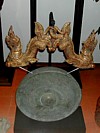Thai. Collective term for gongs, which have
many forms and shapes, but the typical handmade Thai gong always
consists of a flat disc to which the side is welded and which is
hammered into shape that has a centre knob, usually surrounded by
smaller nipples. This design is stenciled on the back of the gong
with a homemade pair of compasses prior to bangers hammering out the
shape into templates engraved into tree stumps that allow for the
knob and nipples
to be hammered out
fully and evenly. After this, the gong is tuned by striking it in
different places to listen for acoustic imperfections. Aiming to
reduce dissonance in the sound frequencies emitted from the gong, a
mallet is then used to make slight alterations. This continues
process of striking, listening and fine-tuning is a job reserved
only for highly skilled tuners who observe and train for many years
to master their skill. Once satisfied with the sound, the gong is
coated in enamel and ready for intricate artworks to be
hand-painted. The price of a handmade gong greatly depends on the
size and the materials used, with metal being the cheapest over the
midrange quality of stainless steal to bronze which is the best and
most expensive material, as well as the work that goes into the
final paintwork, which varies from simple to elaborate. A
large-sized and top quality gong can sell for up to over a million
bath.
Gongs are often found hanging in a
krajang (fig.)
structure; in between the tusks of an elephant; or
from a
mai kaan haab-like
rod held by two
gong bearers,
who are usually made from wood and sometimes adorned with
gilded lacquer
(fig.),
or as in Burmese style: carrying a
plate gong known as
kyi-zi,
rather than a kong
(fig.).
Thai gongs are suspended from the rim which is called
chat, after the
several layered royal umbrella. It is sometimes referred to as kong
mohng (ฆ้องโหม่ง), with the word mohng being an onomatopoeia from
the sound produced by striking the gong. Certain types of gong are
also used in Buddhism (fig.).
Whereas Wat Tham Koo Ha Sawan in
Ubon Ratchathani
has the
World's Largest Gong, the province is also home to the so-called
Village of Gongs in Kong Chiam District, nicknamed Gong Highway,
where the lives of the people in a line of villages are dedicated to
the creation of gongs and where every step in the process of gong
making can be observed. It consists mainly of the area along Sathit
Nimankan Road, a +30 km stretch of road along which more than 50
family-owned gong production companies are located, who collectively
produce around 7,000 gongs each year, from small handheld ones to
the large ones often seen at temples across Thailand. See also
mohng,
TRAVEL PICTURES (1),
(2) and
(3), and
WATCH VIDEO.
回







